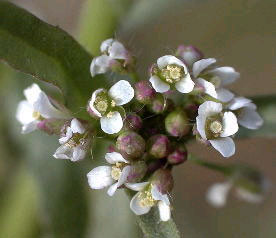Basho’s grootse haiku over een klein bloempje

Als ik voorzichtig kijk, de Nazuna bloeit in de heg! Een haiku van Basho. Een meditatief gedicht. Je moet weten dat de nazuna een nietszeggend bloempje is, maar Basho Ziet de Bloem zoals die is, zonder de context die wij over elk fenomeen draperen. Wij vergelijken alles, omdat dat onze staat van bewustzijn is, Basho ziet de naakte werkelijkheid. Zoals alleen een mysticus kan. Deze haiku geeft aan wat meditatief bewustzijn is en kan zijn.
Deze haiku is van de verlichte meester Basho, en het mooiste commentaar op deze Haiku is dat van Osho.
In het Japans eindigt deze haiku met een opbouw naar het laatste woord, kana. Dat maakt het gehele gedicht tot een soort uitroepteken, een staat van verwondering. Kana is een Japans woord dat onvertaalbaar is, het is meer dan een uitroepteken. Het is een statement.
When I look carefully,
I see the nazuna blooming
by the hedge!
Basho
Now, there seems to be nothing of great poetry in it. But let us go into it with more sympathy, because Basho is being translated into English; in his own language it has a totally different texture and flavour.
The nazuna is a very common flower — grows by itself by the side of the road, a grass flower. It is so common that nobody ever looks at it. It is not a precious rose; it is not a rare lotus. It is easy to see the beauty of a rare lotus floating on a lake, a blue lotus — how can you avoid seeing it? For a moment you are bound to be caught by its beauty. Or a beautiful rose dancing in the wind, in the sun…for a split second it possesses you. It is stunning.
But a nazuna is a very ordinary, common flower; it needs no gardening, no gardener, it grows by itself anywhere. To see a nazuna carefully a meditator is needed, a very delicate consciousness is needed; otherwise you will bypass it. It has no apparent beauty, its beauty is deep. Its beauty is that of the very ordinary, but the very ordinary contains the extraordinary in it, because all is full of God…even the nazunia flower. Unless you penetrate it with a sympathetic heart you will miss it.
When for the first time you read Basho you start thinking, “What is there so tremendously important to say about a nazuna blooming by the hedge?”
In Basho’s poem the last syllable, kana, in Japanese — is translated by an exclamation point because we don’t have any other way to translate it. But kana means, “I am amazed!”
Now, from where is the beauty coming? Is it coming from the nazunia?…because thousands of people may have passed by the side of the hedge and nobody may have even looked at this small flower. And Basho is possessed by its beauty, is transported into another world. What has happened? It is not really the nazunia; otherwise it would have caught everybody’s eye. It is Basho’s insight, his open heart, his sympathetic vision, his meditativeness. Meditation is alchemy: it can transform the base metal into gold; it can transform a nazunia flower into a lotus.
When I look carefully…. And the word carefully means attentively, with awareness, mindfully, meditatively, with love, with caring. One can just look without caring at all, then one will miss the whole point. That word carefully has to be remembered in all its meanings, but the root meaning is meditatively. And what does it mean when you see something meditatively? It means without mind, looking without the mind, no clouds of thought in the sky of your consciousness, no memories passing by, no desires…nothing at all, utter emptiness.
When in such a state of no-mind you look, even a nazuna flower is transported into another world. It becomes a lotus of the paradise, it is no longer part of the earth; the extraordinary has been found in the ordinary. And this is the way of Buddha: to find the extraordinary in the ordinary, to find all in the now, to find the whole in this — Buddha calls it tathata.
Basho’s haiku is a haiku of tathata: this nazuna, looked at lovingly, caringly through the heart, unclouded consciousness, in a state of no-mind…and one is amazed, one is in awe.
A great wonder arises, How is it possible? This nazunia — and if a nazunia is possible then everything is possible. If a nazuna can be so beautiful, Basho can be a buddha. If a nazuna can contain such poetry, then each stone can become a sermon.
When I look carefully, I see the nazuna blooming by the hedge! Kana….
I am amazed. I am dumb. I cannot say anything about its beauty — I can only hint at it.
A haiku simply hints. The poetry describes, the haiku only indicates, and in a very indirect way.
Osho: The Dhammapada: The Way of the Buddha

